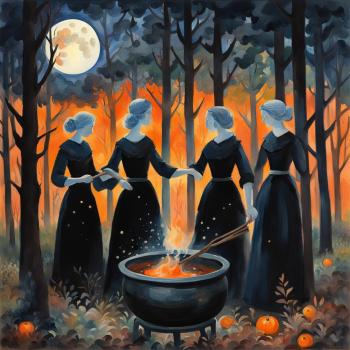 High Priestess’ Disease is an epidemic in many Pagan circles. It can be described as an overinflated view of one’s own importance that afflicts many of us who are just beginning to come into our real power as Witches. In the last column, I detailed the symptoms and possible causes. In this article, I will characterize and explain how to prevent and treat this deadly ailment.
High Priestess’ Disease is an epidemic in many Pagan circles. It can be described as an overinflated view of one’s own importance that afflicts many of us who are just beginning to come into our real power as Witches. In the last column, I detailed the symptoms and possible causes. In this article, I will characterize and explain how to prevent and treat this deadly ailment.
Prevention
If you can head the behaviors off at the pass, you can prevent the development of the disease. If not, you must confront them on a case-by-case basis.
Successful Power Management
Sharing power fairly is an important part of the Craft. Many groups deal with this by consensus decision-making, while others deal with it by establishing a firm hierarchy and delineating a process by which other groups, created under someone else’s leadership, may form. In the first case, often a covert leadership forms in the place of an overt leadership. As long as power is being distributed fairly and all are being given a chance to facilitate (and respected when they are), this is probably just fine. Making sure this process is respected is a cure to power-hunger. Make good use of Talking Sticks, mentorship and shared facilitation, as well as other time-honored methods of power sharing. In the second case, usually a Priestess who has obtained a Second Degree in an initiatory tradition has the right to “hive off” and form her own coven if she doesn’t want to remain under the existing High Priestess’ leadership. As coven leaders, encourage budding Priestesses and Priests who are getting too big for their britches to do so, and take note of your own behavior when you have a rash of defections. In either case, arrogant leaders who refuse to share power or to help others to build their own groups will soon find themselves without groups to lead, whether they led the old group, or the new. That’s a good wake-up call.
Ego-Death
I like to tell my students that one of the keys to successful Wiccan life is developing a “right-sized ego.” Many of us do not appreciate our own significance. We are taught to be humble; and this leads to false humility and an undervaluing of ourselves and our capabilities. Arrogance will cause us to be so busy looking at our own noses that we trip over our feet and look ridiculous; but not appreciating our own capabilities undervalues the hard work of others. When we are comfortable with ourselves we can engage in honest assessment. For instance, I am a reasonably talented singer/songwriter. I know many who are better, and many more who are worse. I am probably good enough to make a living at it if I want to, but not good enough to leave a legacy of lasting value. I am comfortable with this. Initiation is also an excellent coping mechanism. Especially in the Second Degree, we are forced into an ordeal that causes us to confront our fears and our personal issues head-on, because ego is usually a defense against fear–be it fear of hurt, humiliation, pain or fear of death and loss. Initiation helps us to face the transition from one state to another and recognize the pain. If you do not have a formal initiation, in my experience, your path as a Witch will cause life to provide one for you! The firm transition from one state to another is intended to shock the ego into taking a nap and allowing the transformation. It is a valuable tool, like a Rite of Passage marking the transition to adulthood, but it not always successful, and some traditions don’t have initiations. However, those traditions usually speak of the Hero’s Journey and the Mysteries of the Dark Goddess, and the same lessons are learned there.
Growing Up
I find that if Witches are stuck in the acute stage of High Priestess’ Disease, refusing to grow up is usually the cause. In the last column, I described “growing up” as “accepting responsibility.” Victims of High Priestessitis don’t do this well. They always have an excuse, or someone else to blame. You can’t confront your issues unless you admit to them. Be willing to be vulnerable, and to apologize for your mistakes and make restitution for whatever your part was in it, whether the harm you did was intended or not.
Treatment
Treatment is much more difficult than prevention. Long-term care or “shock therapy” is needed. I advise teachers not to take it upon themselves to deliver the shocks, however, other than with initiation. The gods do well enough at that without our help. We can, however, help with long-term care. Teach (and study) the Rede; teach (and practice) honest self-assessment, and encourage (and practice) regular confrontation of the Shadow-Self. I have a meditation for this on my YouTube channel; you are welcome to use it. In some cases, professional therapy may be called for. There’s no shame in this. The Craft is not an easy path. There’s a reason that the weird old Witch at the edge of the woods and the mad, wandering Wizard are stereotypes. Take advantage of modern psychology or ancient shamanic wisdom, and if you delve too deep and find something in there you can’t handle, get someone to help you.
Prognosis
High Priestessitis is 100% preventable and in most cases responds well to therapy, but defense systems of the ego often prevent the afflicted from seeking treatment. Untreated, it leads to alienation, loneliness, and constant confrontation of the ego. In other words, the personal issues of the victim continue to rear their ugly heads again and again and again until lessons are learned, locking her or him into destructive patterns, characterized by the victim’s exasperated cry, “Why does this $%&* keep happening to me?!” This pattern might continue for years. I find, however, that those who genuinely wish for help will actually recover, so don’t be afraid to reach out and ask. Next column: Degrees in initiatory traditions and what they actually mean.
Seekers and Guides is published on alternate Mondays. Follow it via RSS or e-mail!

















